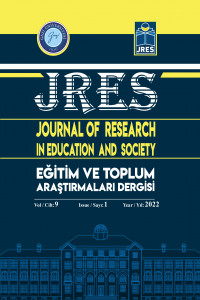Öz
ÖZ
Maslow’un ihtiyaçlar teorisi, çağdaş motivasyon teorilerinin gelişiminin temellerini oluşturmakta ve hâlen hem akademide hem de pratik iş hayatında yönetici ve çalışan motivasyonunun açıklanmasına rehberlik ve kaynaklık etmektedir. Maslow’un ihtiyaçlar teorisine yönelik yapılan eleştiriler ise özünde, ihtiyaçlar teorisinin hiyerarşik yapısı ve kendini gerçekleştirme safhasına yönelik olarak yaygın ve yüzeysel bir şekilde gerçekleştirilen, yani modelin kendisiyle ilgili bir yanlışlama içermeyen birtakım indirgemeci yaklaşım ve tenkitlerden ibarettir. Bu çalışmayı diğerlerinden ayırt eden en önemli hususiyet ise, kritikle birlikte modelin yeniden açıklanmasına yönelik yeni bir yorumun getirilmiş olmasıdır. Bu kapsamda bu çalışmada evvela model Maslow’un ortaya koyduğu şekliyle birincil kaynaklardan istifade ile izah edilecek, sonrasında modelin hiyerarşik yapısına yönelik eleştiriler toparlanacak ve modelin kendini gerçekleştirme safhası sofistike bir bakış açısıyla yeniden irdelenecek ve son bölümde ise modelin yeniden bütünleşik bir biçimde yeniden yorumlanmasına yönelik bir öneri ortaya koyulacaktır.
Anahtar Kelimeler
Kaynakça
- Bowdon, T.B. (2003). 50 self-help classics: Motivation and personality. Boston: Nicholas Brealey.
- Burton, N. (2012). Our hierarchy of needs. Open Journal of Social Sciences, 8 (1).
- Fallatah, R.H.M. ve Syed, J. (2018). A critical review of Maslow’s Hierarchy of Needs. Employee Motivation in Saudi Arabia içinde (s. 19-59). London: Palgrave Macmillan.
- Frager, R.D. ve Fadimam, J. (1997). A.H. Maslow, motivation and personality. New Jersey: Pearson.
- Goble, F. G. (2004). The third force: The psychology of Abraham Maslow. F.L: Maurice Bassett.
- Hoffman, E. (1998). The right to be human: A biography of Abraham Maslow. New York: St. Martin's.
- King-Hill, S. (2015). Critical analysis of Maslow’s Hierarchy of Need. The Step Journal (Student Teacher Perspectives), 2(4). 54-57.
- Maslow, A. (1943). A theory of human motivation. New York: Harper and Row.
- Maslow, A. (1954). Motivation and personality. New York: Harper and Row.
- Maslow, A. (1962). Toward a psychology of being. New York: Harper and Row.
- Maslow, A., Deborah, C. S. ve Gary, H. (1998). Maslow on management. Weinheim: Wile.
- Robbins, S. P. ve Judge, T. A. (2013). Örgütsel davranış. (İ. Erdem, Çev.). İstanbul: Nobel.
- Şengöz, M. (2019). Yönetim felsefesi: Gazi Paşa’nın perspektifinden aksiyolojik liderlik üzerine mülahazalar. Ankara: Astana.
Öz
ABSTRACT Maslow's theory of needs underlies the development of contemporary motivation theories and it still guides and serves as a source for the explanation of executive employee motivation in both academia and practical business life. Criticisms of Maslow's theory of needs essentially consist of widespread and superficial criticisms of the hierarchical structure of the theory of needs and the self-actualization phase. In other words, the criticisms made consist of a number of reductionist approaches and criticisms that do not contain any falsifications about the model itself. In this context, the most important feature that distinguishes this study from others is that a new interpretation has been introduced for the reconstruction of the model together with the critique. For this reason, firstly, the theory of needs model as proposed by Maslow will be explained in this study by using primary sources. Then the criticisms of the hierarchical structure of the model will be collected and the self-actualization phase of the model will be re-examined from a sophisticated point of view. In the last part, a new interpretation of the model will be presented in the form of an integrated set of needs.
Anahtar Kelimeler
Kaynakça
- Bowdon, T.B. (2003). 50 self-help classics: Motivation and personality. Boston: Nicholas Brealey.
- Burton, N. (2012). Our hierarchy of needs. Open Journal of Social Sciences, 8 (1).
- Fallatah, R.H.M. ve Syed, J. (2018). A critical review of Maslow’s Hierarchy of Needs. Employee Motivation in Saudi Arabia içinde (s. 19-59). London: Palgrave Macmillan.
- Frager, R.D. ve Fadimam, J. (1997). A.H. Maslow, motivation and personality. New Jersey: Pearson.
- Goble, F. G. (2004). The third force: The psychology of Abraham Maslow. F.L: Maurice Bassett.
- Hoffman, E. (1998). The right to be human: A biography of Abraham Maslow. New York: St. Martin's.
- King-Hill, S. (2015). Critical analysis of Maslow’s Hierarchy of Need. The Step Journal (Student Teacher Perspectives), 2(4). 54-57.
- Maslow, A. (1943). A theory of human motivation. New York: Harper and Row.
- Maslow, A. (1954). Motivation and personality. New York: Harper and Row.
- Maslow, A. (1962). Toward a psychology of being. New York: Harper and Row.
- Maslow, A., Deborah, C. S. ve Gary, H. (1998). Maslow on management. Weinheim: Wile.
- Robbins, S. P. ve Judge, T. A. (2013). Örgütsel davranış. (İ. Erdem, Çev.). İstanbul: Nobel.
- Şengöz, M. (2019). Yönetim felsefesi: Gazi Paşa’nın perspektifinden aksiyolojik liderlik üzerine mülahazalar. Ankara: Astana.
Ayrıntılar
| Birincil Dil | Türkçe |
|---|---|
| Bölüm | Derleme Makale |
| Yazarlar | |
| Erken Görünüm Tarihi | 25 Haziran 2022 |
| Yayımlanma Tarihi | 28 Haziran 2022 |
| Gönderilme Tarihi | 2 Ağustos 2021 |
| Yayımlandığı Sayı | Yıl 2022 Cilt: 9 Sayı: 1 |
Cited By
Asrın Felaketi Sonrası Maslow’un İhtiyaçlar Hiyerarşisine Göre Nereden Nereye?
International Journal of Entrepreneurship and Management Inquiries
https://doi.org/10.55775/ijemi.1398429
Hz. Peygamber'in (s.a.v.) Kur'ân'ı Öğretim Sürecinden Pedagojik Yansımalar
Cumhuriyet İlahiyat Dergisi
https://doi.org/10.18505/cuid.1517494
Organizational Overview of Maslow and Management Research
Türk Psikolojik Danışma ve Rehberlik Dergisi
https://doi.org/10.17066/tpdrd.1332600_10
NEO-KLASİK YAKLAŞIMIN KATKILARI: MODERN İŞ DÜNYASINDA HÂLÂ GEÇERLİ Mİ?
Nevşehir Hacı Bektaş Veli Üniversitesi SBE Dergisi
https://doi.org/10.30783/nevsosbilen.1289195

This work is licensed under a Creative Commons Attribution-NonCommercial-NoDerivatives 4.0 International License.


